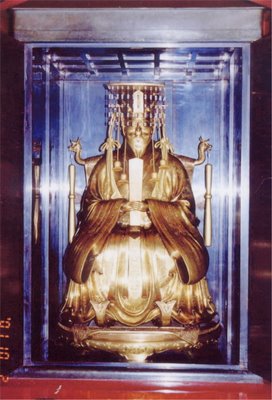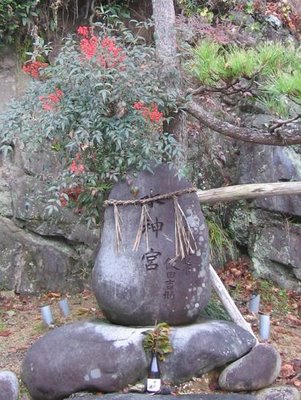. Persons and People of Edo - Personen .
::::::::::::::::::::::::::::::::::::::::::::::::::::::::::::::::::::::::::::::::::::::::::::::::::::::::::::::::::::::::::::::::::::::::::::::::::::::::::::::::::::::::::::::::::::
The Edo Clan of the Musashi Taira 武蔵江戸氏 Musashi Edo-Shi
They lived in the hamlet 江戸郷 Edo Go, their Homeland in the Musashi Plain. It was located in the
日比谷の入江 Hibiya no Irie inlet.
Edo 江戸 means "estuary", lit. "inlet door", "entrance to the inlet".
eto 江門 was another old spelling of this area.
Other clans who lived in the Edo area before Tokugawa Ieyasu established the Bakufu government:

畠山氏 Hatakeyama clan in 深谷 Fukaya
河越氏 Kawagoe clan in 川越 Kawagoe
豊島氏 Toyoshima clan in 川口 Kawaguchi
. Hibiya 日比谷 / 比々谷 district in Edo .
..............................................................................................................................................
- quote
The Edo clan were a minor offshoot of the Taira clan,
and first fortified the settlement known as Edo, which would later become Tokyo. The Imperial Palace now stands at this location.
During the Azuchi-Momoyama period, the clan was renamed the 武蔵喜多見氏 Musashi Kitami clan.
The clan originated in Chichibu in Musashi Province (now Saitama Prefecture). In the late 12th century,
江戸重継 Edo Shigetsugu (Chichibu Shigetsugu) moved south and fortified the little hill at Edo, located where the Sumida River enters Tokyo Bay. This area later became the Honmaru and Ninomaru portions of Edo Castle. There, the Edo grew in military strength under the second patriarch, Edo Shigenaga 江戸重長.
In August 1180, Shigenaga attacked Muira Yoshizumi, an ally of the rival Minamoto clan. Three months later, he switched sides just as Minamoto Yoritomo entered Musashi. Shigenaga assisted the Minamoto in overthrowing the Taira in Kyoto. In return, Yoritomo granted Shigenaga seven new estates in Musashi Province, including Kitami in what is now Tokyo's western Setagaya Ward.
Records show that in 1457, Edo Shigeyasu surrendered his main base at Edo to Ota Dokan. Dokan was a vassal of the powerful Ōgigayatsu branch of the Uesugi clan under Uesugi Sadamasa. Sadamasa was the Kanto-Kanrei for the Ashikaga. Dokan built Edo castle on the site. The Edo clan then moved to Kitami.
In 1593, in a pledge of obedience to Tokugawa Ieyasu, Edo Katsutada changed the clan name to Kitami. Katsutada was employed by the first and second Tokugawa shoguns, reaching the position of Magistrate of Sakai, south of Osaka. Katsutada's grandson-in-law, Shigemasa, found favor with the fifth shogun Tokugawa Tsunayoshi. He rose from the position of hatamoto, with a stipend of one thousand koku, to sobayonin, or "Grand Chamberlain", with a stipend of twenty thousand. It was an influential post, responsible for relaying messages between the shogun and his senior councilors. He was also awarded a large domain in 1686. However, the clan's fortunes suddenly plummeted. In 1689, Shigemasa's nephew violated the Shogunate taboo on bloodshed. Shigemasa had to forfeit his status and property and was banished to Ise, where he died in 1693 at age 36. The 500-year-old Edo clan essentially ceased as a recognized clan.
Tombstones of several generations of the clan are at 慶元寺 Keigen-Ji, a Buddhist temple founded in 1186 by Edo Shigenaga, in Kitami.
The name later changed to 常陸江戸氏 Hitachi Edo-Shi.
- source : wikipedia

江戸重長 Edo Taro Shigenaga
was the second head of the Edo clan. He first settled and lent his name to the fishing village Edo that eventually grew to become Tokyo.
He was also known as Edo Taroo 江戸太郎 Edo Taro.
In 1180, Shigenaga was asked by Minamoto Yoritomo to cooperate in his uprising against rule of the Taira in Kyoto. Hesitant at first, Shigenaga eventually helped Yoritomo overthrow the Taira rule. Yoritomo granted Shigenaga seven new estates in Musashi Province, including Kitami in what is now Tokyo's western Setagaya Ward.
..............................................................................................................................................

source : 4travel.jp/travelogue/10825822
Graves of the Musashi Kitami Clan - 江戸氏之墓所
慶元寺 Keigen-Ji - see below
..............................................................................................................................................
- quote -
The ones who got there first
Four centuries before Tokugawa Ieyasu arrived at Edo, a fierce band of mounted warriors had already fortified the hill where Ieyasu would build his magnificent Edo Castle, and on which the Imperial Palace now stands.
In the late 12th century, the Edo clan, as these warriors called themselves, had moved south from Chichibu in present-day Saitama Prefecture led by their patriarch, Edo Shigetsugu. Seizing Edo, they rapidly built up their military presence in the southern Kanto Plain to such a point that, in 1180, Shigenaga, the second clan head, was asked by Minamoto Yoritomo (1147-99) to cooperate in his uprising against the great Taira family in Kyoto.
Shigenaga was not easily persuaded, but eventually lent his power to Yoritomo in overthrowing Taira rule. In appreciation, Yoritomo granted Shigenaga seven new estates in Musashi Province, including Kitami in what is now Tokyo’s western Setagaya Ward.
Little is known about the Edo clan in the turbulent Kamakura Period that began with Yoritomo’s founding of a shogunate in that city in 1192; nor do we know of their fate during the Kyoto-based shogunate known as the Muromachi Period, that ran from 1338-1573. However, records show that in 1457, Edo Shigeyasu surrendered his main base at Edo to Ota Dokan (1432-86), a vassal of Uesugi Sadamasa, Governor of the Kanto Plain, and moved to Kitami. Dokan then built a castle on the site with views of Mount Fuji and Edo Bay, before being killed by an assassin sent by his own master in 1486. The castle was then abandoned until it was taken over by Ieyasu in 1590.
In a pledge of obedience to Ieyasu, Edo Katsutada changed the clan name to Kitami in 1593. Katsutada was employed by the first and second shoguns, reaching the position of Magistrate of Sakai, south of Osaka.
His grandson-in-law, Shigemasa, bathed in the special favor of the fifth shogun and rose to the rank of daimyo by 1682. Promoted to a sobayonin (grand chamberlain), whose influential role was to relay messages between the shogun and his senior councilors, he was awarded a further large domain in 1686.
From this zenith of happiness, however, Shigemasa’s fortunes plummeted — and with them, those of the Edo clan. In 1689, Shigemasa’s nephew violated the shogunal taboo on bloodshed and the family was held collectively responsible. As punishment, Shigemasa forfeited his status and all property and was banished to Ise, where he died in 1693 at age 36. His kin was similarly punished, and with that the 500-year-old Edo clan vanished.
To this day, however, memories of the first possessor of Edo linger on at Keigen-ji in Kitami, Setagaya Ward, an impressive Buddhist temple founded in 1186 by Edo Shigenaga. Tombstones of several generations of the clan, some quite eroded but others recently renovated, huddle together in a corner of the graveyard, tied eternally by their invisible bond of kinship.
- source : Japan Times 2003 - Sumiko Enbutsu -
::::::::::::::::::::::::::::::::::::::::::::::::::::::::::::::::::::::::::::::::::::::::::::::::::::::::::::::::::::::::::::::::::::::::::::::::::::::::::::::::::::::::::::::::::::
Keigenji 慶元寺 Keigen-Ji
永劫山 花林院 慶元寺 Eigosan Karin-In Keigen-Ji
世田谷区喜多見4-17-1 / 4 Chome-17-1 Kitami, Setagaya ward
浄土宗 Jodo Sect.
Apart from the main temple hall, it has a 鐘楼 bell tower and a 三重堂 three-story pagoda.

source and more photos : tesshow.jp/setagaya
The main statue is 阿弥陀如来 Amida Nyorai.
Edo Taro Shigenaga founded this temple, then called 岩戸山大沢院東福寺 Tofuku-Ji in 1186, which then belonged to the 天台宗 Tendai sect.
In 1451 it was relocated to 成城(元喜多見) Seijo (Moto Kitami) and found its final place in 1468.
In 1540, the priest 空誉上人 / 空与(空與)/ 空与守欣上人 Kuyo Shonin revitalized the temple, which had lost its importance. The name changed 上山華林院慶元寺 and now it belonges to the Jodo Sect.
In 1636, Shogun Iemitsu awarded the temple with land of 10石 (about 1ha(10000㎡), annexing 6 temples in the neighborhood.
Number 4 in the pilgrimage to 33 Kannon temples along the Tamagawa 多摩川三十三ヶ所観音霊場.

::::::::::::::::::::::::::::::::::::::::::::::::::::::::::::::::::::::::::::::::::::::::::::::::::::::::::::::::::::::::::::::::::::::::::::::::::::::::::::::::::::::::::::::::::::
Kitami eki 喜多見駅 Kitami station
on the Odakyu Railway Line, on the border between Setagaya Ward and Komae City.
The name of the area,
Kitami, (also written 北見)
is thought to originate from an ancient Ainu word meaning "flat, wooded place".
- quote wikipedia -

.......................................................................
- Some further History -
... The Kantō Plain appears to have first been populated in the Late Jōmon Period sometime after 3100 BC. ...
... Kofun Period (200-500 AD) : It seems that around the 300’s, Kantō became a vassal state of the Yamato Court. There are more than 200 Kofun in the Tōkyō Metropolis.
丸山古墳 Maruyama Kofun “Round Mountain” Kofun is in 芝公園 Shiba Kōen park ...

... “A feudal warlord named Ōta Dōkan came into the small fishing village of Edo and built his castle there.”...
... “Though it was once an insignificant village in the marshy wetlands,
Tokugawa Ieyasu transformed Edo into a glorious capital befitting of the shōgun.”...
... The Edo clan still had a residence in Kitami, which is present day Setagawa Ward. In light of Tokugawa Ieyasu’s dominance over the area, it would be presumptuous (and confusing) for a clan to retain the name of the capital city when a new daimyō, appointed by the unifier of Japan, controlled that city. So in 1593, taking an oath of submission and fealty to Tokugawa Ieyasu, the last Edo Clan daimyō gave up the name Edo and assumed the name, Kitami, which was where their primary holdings were. ...
... In 1693, the direct family line, no longer Edo but Kitami, was extinguished after the banishment of Kitami Shigeyasu to Ise when his grandson murdered somebody or something.
... At the height of Tokugawa power, the castle is said to have been the biggest in the world and the city was likely the most populous.
- More details and history about the name of EDO -
- source : japanthis.com/2013 -
. Oota Dookan 太田道灌 Ota Dokan (1432 - 1486) .
. kofun 古墳 burial mounds in Tokyo .
.......................................................................
- - - - - Now we come to September 3rd, 1868 :
慶応4年7月17日(西暦では1868年9月3日)
Edo o shooshite Tōkyō to nasu shoosho 江戸を称して東京と為すの詔書
江戸ヲ称シテ東京ト為スノ詔書

Imperial Edict Renaming Edo to Tōkyō.
私は、今政治に自ら裁決を下すこととなり、全ての民をいたわっている。
江戸は東国で第一の大都市であり、四方から人や物が集まる場所である。当然、私自らその政治をみるべきである。よって、以後江戸を東京と称することとする。これは、私が国の東西を同一視するためである。
国民はこの私の意向を心に留めて行動しなさい。
"I at this time settle all matters of state myself in the interest of the people.
Edo is the largest city in the eastern provinces, a place in which things gather from every direction. It were well that
I should personally oversee its governance. Therefore from this time on I shall call it“Tokyo”(Eastern Capital).
This is so that I might oversee all affairs in the land equally, from east to west.
Let the people heed this my will."
- reference source : wikipedia -
::::::::::::::::::::::::::::::::::::::::::::::::::::::::::::::::::::::::::::::::::::::::::::::::::::::::::::::::::::::::::::::::::::::::::::::::::::::::::::::::::::::::::::::::::::
- reference : Edo Shigenaga -
- reference : Kitami Edo Tokyo -
::::::::::::::::::::::::::::::::::::::::::::::::::::::::::::::::::::::::::::::::::::::::::::::::::::::::::::::::::::::::::::::::::::::::::::::::::::::::::::::::::::::::::::::::::::

- - - To join me on facebook, click the image !
:::::::::::::::::::::::::::::::::::::::::::::::::::::::::::::::::::::::::::::::::::::::::::::::::::::::::::::::::::::::::::::::::::::::::::::::::::::::::::::::::::::::::::::::::::::
. Edo bakufu 江戸幕府 The Edo Government .
. Famous Places and Powerspots of Edo 江戸の名所 .
. Doing Business in Edo - 商売 - Introduction .
[ . BACK to DARUMA MUSEUM TOP . ]
[ . BACK to WORLDKIGO . TOP . ]
- - - - - #edoclan #edoshigenaga #kitamitokyo #edohistory #hibiya #clan - - - -
::::::::::::::::::::::::::::::::::::::::::::::::::::::::::::::::::::::::::::::::::::::::::::::::::::::::::::::::::::::::::::::::::::::::::::::::::::::::::::::::::::::::::::::::::::




























